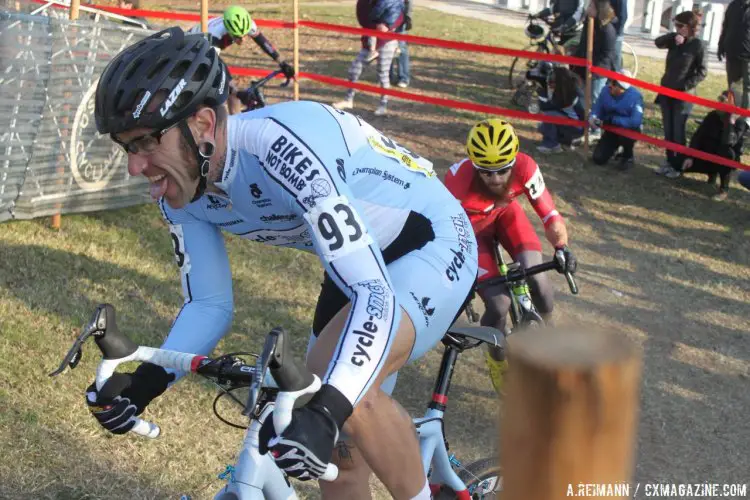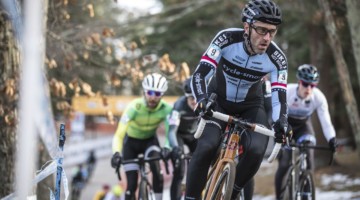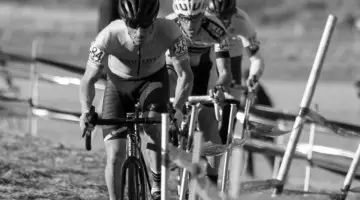Last week for Technique Tuesday, Adam Myerson planned out the steps that riders should take when opening up for a race weekend. While gravel racers often only have to worry about the “one big event” of a week, cyclocrossers often find themselves pulling double-duty on the weekend (especially if they have an understanding or equally race-enthused family). Although Myerson’s advice focuses on road weekend races, which plenty of cyclocrossers are doing in the offseason, much of these tips are insightful for the fall racing ahead as well.
You can find other training ideas and articles at cycle-smart.com, as well as information on internationally-recognized coaching and clinic programs for all skill levels.
by Adam Myerson
No matter what your body type or racing preference, most of us at some point will find ourselves focusing on a stage race or multi-day criterium series. Each region of the US has that one big event that local riders anchor their season around. In New England it’s traditionally been races like Killington, Fitchburg, and Green Mountain. In Wisconsin it’s now Tour of America’s Dairyland, and Superweek before that. Those are just a couple of examples, and I’m sure you have one in mind for this season. Assuming you’ve done all you can training-wise leading up to the event you’re targeting, it’s important not to waste any of that precious form while the event is actually happening and in the days before. Maximizing recovery during and between stages is crucial to having your best performance.
If you’re on a pro team with a good budget, then there’s a whole staff of people whose job it is to make your life as easy as possible and assist you with your recovery. There’s usually someone doing the driving, cleaning and tuning bikes, washing the laundry, filling the bottles and feedbags, and rubbing tired legs and backs each night. Most of us aren’t in that situation, but there are still a lot of little things you can do on your own to help yourself be as close to 100% recovered as possible before the next stage.
Go In Rested
You’re most likely going to be coming off one or two days of racing the weekend before your event, and only have a few days to recover before a stage race or crit series begins mid-week. Remember that in the week leading up to a multi-day race, there isn’t much you can do to improve the fitness you have. You’ve got what you’ve got, and there’s no time to stress your system, let it recover, adapt. and improve. That window is closed, and at this point, your only goal is to go into the race as fresh and rested as possible, so that your ability to recover is at it’s best. You need to be recovered from the very process of having to recover. This means that in the days between the weekend of racing previous, and the start of the stage race, you’re typically looking for active recovery days across the board. If the race starts very early in the week, you might even skip the weekend of racing previous.
The exception to this might be a situation where a stage race starts with a time trial. If winning the TT was your main focus and goal because you’re racing for GC, you might do an opening up workout of some tempo, threshold, and sprints the day before. If you’re looking for consistency over the race days as a whole, resting up to the start is best if the event is longer than 3 days. If the time trial is not a priority and your focus is on stages down the road, coming in cold and using the TT stages as an opener is a great strategy.
Warming Up and Cooling Down
Of the two, I find cooling down to be the most important. The minute your race is over, recovery and preparation for the next day begins. At least 15 minutes of easy riding on the road or a trainer will start the process of clearing waste from muscles through increased blood flow. Further, if your races are early, a separate PM spin is another approach. If you can get on the rollers or trainer for 15-20 minutes after dinner it’s the next best thing to a massage each night. Part of what you’ll be experiencing is muscle damage, not just carbohydrate depletion. Conversely, if you’re racing a crit series where the stages are in the afternoon, a morning spin serves the same purpose.
Warming up is important, but less crucial, provided you get a good cool down or morning ride. When you’re racing this much, your legs will open up quickly. This doesn’t mean going from the car to the start line, it simply means that an easy spin of 15 minutes, just to make sure your bike works and that you’re ready to go is all your should need.
The major exception to this, of course, is a short time trial or stage where you start with a climb, where you might need to do a more specific and intense warm up that touches on some of the intensity you’ll have to do right off the bat. Even in that case, just touching the power you’ll need to do in the race once or twice for as little as 30 seconds will often be sufficient.
Food
You should divide your eating for any race day into three categories: before, during, and after, but there are special considerations for multi-day races. In the mornings, I prefer athletes eat a meal consisting of their normal breakfast. Race day is not the day you want to vary your routine and experiment with new foods. Generally, you want to eat foods that are high in carbohydrates, but low on the glycemic index, avoiding simple sugars. Make sure to get include protein and fat as well to keep your insulin/blood sugar level even. A bowl of oatmeal with raisins and a spoonful of peanut butter is a reasonable choice.
During the race, it’s critical to put a lot of effort into almost forcing yourself to eat and drink. You’ll likely be burning somewhere close to 1000 calories an hour when you’re racing depending on your size, and while it’s impossible to consume and digest that amount on the bike, you have to account for it somehow. If you have a powermeter, you know exactly what you’re doing in the races, but again, race day is not where you want to be experimenting with eating, and you want to have sorted this out in training by this point.
A drink mix in the 3% range that focuses on hydration rather than calorie replacement is the best choice, while using solid food to get your calories. Many people struggle to eat solid food and like to rely on carbohydrate gels and blocks, but it’s easy to overload your gut with these trying to replace all the calories you burn. 250 total calories an hour is a typical rate for most people, but again, it varies by body size. If you get naseated during the race it may be from too many carbohydrates rather than not enough fluids. A strongly mixed bottle and too many gels will shut your digestion down, and often lead to stomach cramping after the race we fondly refer to as “‘cross gut.” It happens frequently to people after cyclocross races because the events are short and intense, and people have a tendency to overeat on carbs before them trying to make sure they’re well fueled. In the summer months especially, the hotter the temperature and more bottles you’ll run through, the stronger the argument for a weaker mix in your bottles.
Your recovery drink after the race in a multi-day event, both in terms of protein and carbohydrates, is one of the most important parts of the equation. Again, you’re not going to be able to eat enough to put back the calories you’ll burn, but this isn’t the place to be trying to lose weight. It’s important to make sure you have your drink mixed, ready, and waiting for you in your cooler when you get back to your car or hotel room. This way you can have it in the first hour after finishing, and then eat a normal meal when you’ve cleaned up.
For this you want something that’s 4:1 or 3:1 carbohydrates to protein. The post-race or post-ride drink is prefer is a smoothie made from 8 oz of soy milk, 25 g of soy protein powder, frozen berries, and a banana. I personally use soy protein over the more common whey protein because I try to avoid dairy products, but you’ll find whey protein in just about every pre-made recovery drink on the market. Whey protein is considered to be more absorbable by your body, and its high glycemic index is theorized to also help your body absorb more of the carbohydrates when consumed together. There are, of course, many popular, pre-made recovery mixes on the market, and the key is to find one you like, in the right ratio.
Perhaps most importantly over the course of a multi-day race, when you’re not on your bike you should never be without a bottle of water in your hand.
Sleep and Napping
If you’re staying at a hotel near the race and have taken time off from work to do the event, you might find yourself with more free time than you’re used to. Sometimes going on the road for races can be one of the most relaxing things you can do, because all the responsibility of work and home are removed. Make the most of that by trying to get caught up on all that sleep you deprive yourself of in a normal work week. After the stage, don’t hang around talking in the parking lot. Get yourself cleaned up, have your recovery food, close the shades, and take a nap. A 30-60 minute sleep will speed your recovery better than almost anything else you can do.
In the evening, keep your distractions to a minimum, and find relaxing, sleep inducing things to do after dinner. I find that if the TV’s on in the hotel room, I’m up until 2 in the morning. As you get more fatigued over the course of a multi-day event, you’ll start to feel some symptoms of over-training, one of which is poor sleep. Turn the TV off, and perhaps read yourself to sleep to help calm your mind and body. If you’re doing a crit series with twilight races, the effect is even more profound, especially as the week goes on. 4 am bedtimes are not uncommon.
Each one of these topics could merit an article in itself, but I’ve done my best here to try to touch on each of them and highlight the aspects I think are most important. Many of these strategies aren’t just good for stage race scenarios, but can also be applied to a two-day weekend of racing, or a hard training block during the week. The most important thing to keep in mind is that if you’ve taken days off from work and shelled out a few hundred bucks to participate in a big stage race, don’t let your money and hard training go down the drain. Every pedal stroke you make adds up, as does every little thing you do off the bike. Stay vigilant, focused, and organized, implement these guidelines, and you’ll have eliminated some of the variables that could pop up and throw you off the track towards your best result.





























